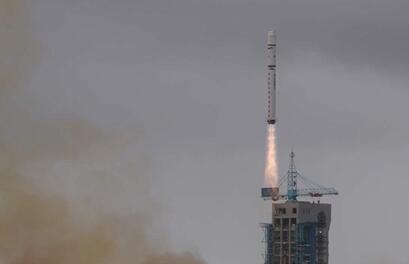


China launched Venezuela’s remote sensing satellite, the VRSS-2, on Oct. 9, 2017.
China’s remote sensing satellites have started to provide “sub-meter” images for foreign clients by using continuously upgraded technologies, stdaily.com reported on Tuesday.
On Monday, China launched Venezuela’s remote sensing satellite, the VRSS-2, into a preset orbit from the Jiuquan Satellite Launch Center in northwest China's Gansu province.
The satellite will be used by Venezuela to evaluate land resources and for environmental protection, disaster monitoring and management, crop yield estimation, and city planning.
Scientists with the China Academy of Space Technology (CAST), developer of the VRSS-2, said the satellite will outperform its predecessor, the Venesat-1, Venezuela’s first satellite launched by China in 2008. The better performance is mainly attributed to two cameras installed on the satellite, a high-resolution camera, and an infrared camera.
The high-resolution camera, which is about the same size as a study table, has a resolution of less than one meter, according to its chief designer with CAST. This resolution allows viewers to tell the difference between a bus and a small car.
The infrared camera, which is about the same size as an A3 printer, enables the VRSS-2 to capture images 24 hours a day at minus 215 degrees centigrade, according to its chief designer. To make sure the infrared camera works, the developers have installed a refrigerator to control heat.
The VRSS-2 satellite was launched by a Chinese Long March-2D carrier rocket designed by the Shanghai Academy of Spaceflight Technology.
 Fire brigade in Shanghai holds group wedding
Fire brigade in Shanghai holds group wedding Tourists enjoy ice sculptures in Datan Town, north China
Tourists enjoy ice sculptures in Datan Town, north China Sunset scenery of Dayan Pagoda in Xi'an
Sunset scenery of Dayan Pagoda in Xi'an Tourists have fun at scenic spot in Nanlong Town, NW China
Tourists have fun at scenic spot in Nanlong Town, NW China Harbin attracts tourists by making best use of ice in winter
Harbin attracts tourists by making best use of ice in winter In pics: FIS Alpine Ski Women's World Cup Slalom
In pics: FIS Alpine Ski Women's World Cup Slalom Black-necked cranes rest at reservoir in Lhunzhub County, Lhasa
Black-necked cranes rest at reservoir in Lhunzhub County, Lhasa China's FAST telescope will be available to foreign scientists in April
China's FAST telescope will be available to foreign scientists in April "She power" plays indispensable role in poverty alleviation
"She power" plays indispensable role in poverty alleviation Top 10 world news events of People's Daily in 2020
Top 10 world news events of People's Daily in 2020 Top 10 China news events of People's Daily in 2020
Top 10 China news events of People's Daily in 2020 Top 10 media buzzwords of 2020
Top 10 media buzzwords of 2020 Year-ender:10 major tourism stories of 2020
Year-ender:10 major tourism stories of 2020 No interference in Venezuelan issues
No interference in Venezuelan issues
 Biz prepares for trade spat
Biz prepares for trade spat
 Broadcasting Continent
Broadcasting Continent Australia wins Chinese CEOs as US loses
Australia wins Chinese CEOs as US loses